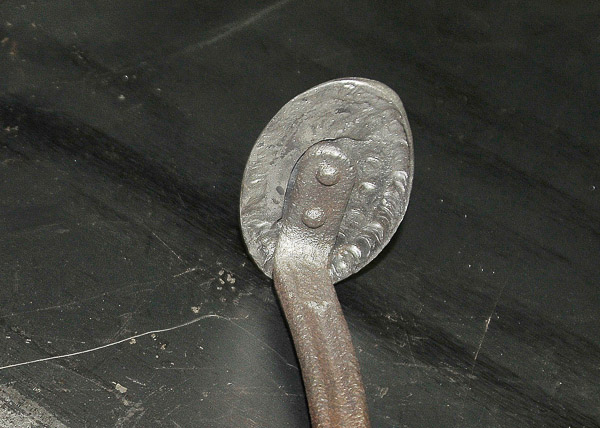
This ancient spring clip has been glass beaded but still retains oxidative etching. Gas welding with ER70-S series filler rod floats out impurities and provides the tensile needed. Gas welding is an excellent alternative in this case, as TIG or even MIG requires cleaner metal. Broad heat diffusion and proper cooling will result in a stable, strong piece.

Most would toss out this brake pedal. What if your Jeep 4WD is so old that the pedal is obsolete? This is a restorable part, as you will see.

First step was thorough glass bead blasting to remove rust scale and surface impurities. Here, I gas weld a 0.120″ piece of mild steel plate to the backside of the pedal, beginning with tack welds and filler rod.

Gas welding offers ready control of heat. As you will learn in my step-by-step videos on gas welding, this ability can be an asset. Controlling heat, I carefully weld the plate and surrounding areas. This pedal face was actually paper-thin in places and required skilled manipulation of the torch as the filler rod dipped into the molten metal.

After careful welding of the backside, the reinforced and built up areas provide stability for gas welding dimples of metal atop each worn out button. A Dremel tool with grinding point serves to sculpt the buttons to their original shape. Jeep restoration work is artful and rewarding.

Finished welding and reinforcement on the backside of the pedal is far stronger than OE approach. This pedal should outlast the original by decades. Welding skill can improve your Jeep 4WD.

Primered with a durable, rust inhibiting primer, I will finish coat this pedal with a catalyzed epoxy paint for smooth fill and wear resistance.

Unseen backside of the pedal is now heavily reinforced and stable. Gas welding’s heat diffusion and a room temperature cooldown produce good tensile for this application. The filler rod is 70,000 PSI minimum, offering strength and desired ductility for this application.

A damaged spring clip is cleaned with glass beading, washed and welded by gas/oxygen-acetylene process. Here, I control the heat and run a filler bead over the prepared and aligned corner of the bracket.

Here is a unique and useful place for gas welding. Chrome plated bracket is not a candidate for TIG welding, which requires pure and spotlessly clean base metal. Thin metal like this would be difficult to MIG as well. Oxygen-acetylene/gas welding is a solution.

The bead shown is a reinforcement on the back side. Combined beads make this vulnerable piece much stronger than original stamping.

Fine control of heat and a smaller welding tip enable pinpoint gas welding with practice. These welds look much like TIG. Mastering gas welding is an excellent foundation for the TIG welding process.

This small machine nut can benefit from gentle tack welding with gas. Gas welding at this level takes finesse and a strong sense for the base metal, precise control of heat and the proper, timely fusion of welding rod. Practice can make this possible! Screw holds nut in place and will preserve the threads as well.

